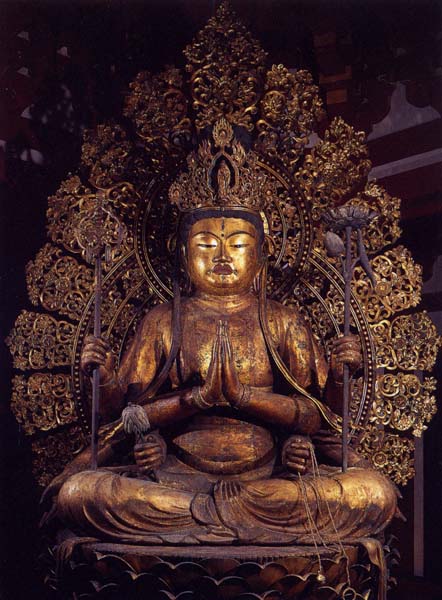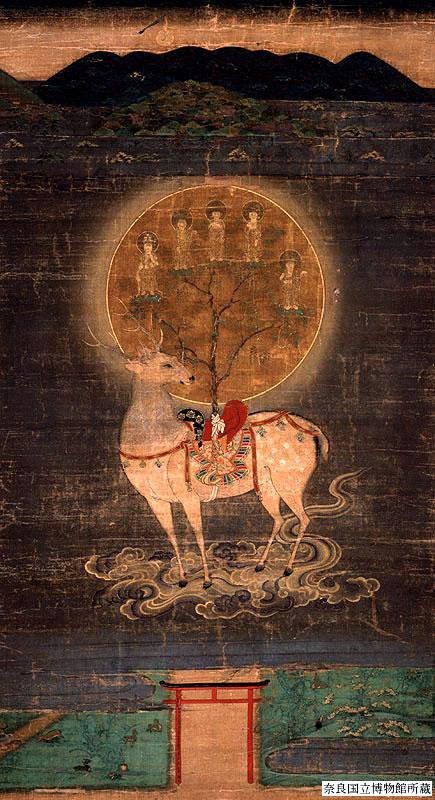
Nanendo (南円堂), translated as “Southern Octagonal Hall,” is a Buddhist sub-temple of Kōfukuji in Nara, the head temple of the Hossō school of Buddhism. It is Temple 9 on the Saigoku Kannon 33 Pilgrimage. Built in 813 by Fujiwara no Fuyutsugu and consecrated by Kōbō Daishi, Nanendo stands at the southwest corner of the vast Kōfukuji complex. Though smaller than the main halls, it has long been the focal point of esoteric rituals and remains a place of deep devotion. The hall opens to the public only once a year, on October 17th, when its sacred image is revealed.
Honzon – Fukukenjaku Kannon
The principal image is Fukukenjaku Kannon (Kannon Who Holds the Rope and Net). This 2.3-meter-tall statue was sculpted in the Kamakura period by Kokei, father of the famous Unkei, after the original temple complex was destroyed in the Heike War of 1180. The first Fukukenjaku Kannon was said to have been carved by Kōbō Daishi himself for Fujiwara no Takamaro and later enshrined here by Fuyutsugu.

Depicted with three eyes and eight arms, Fukukenjaku Kannon holds implements to “catch” all beings and lead them to liberation. Surrounding the statue are six figures of Hossō patriarchs, also carved by Kokei, all designated as National Treasures. This Kannon is especially revered for family safety, health and longevity, prosperity of descendants, and for helping people overcome destructive passions such as anger, lust, and addictions.
Things to See at Nanendo
Nanendo Hall
The octagonal hall, rebuilt in 1741, follows the original Chinese-inspired design. It symbolically represents Mt. Fudaraku, the southern paradise of Kannon.
Hitokoto Kannon
A small adjacent hall enshrines the “Kannon of One Word.” It is believed that a single, sincere utterance of prayer here can bring salvation.
Wisteria Trellis
The trellis in front of the hall blooms spectacularly each spring. Wisteria (fuji) is symbolic of the Fujiwara clan, who founded the temple and held immense power during the Heian era.
Deer Park
The temple grounds are part of Nara Park, home to thousands of tame deer considered sacred messengers of the gods. The deer also recall the Deer Park in India, where the Buddha gave his first sermon.
Fudō-dō
Across the courtyard is a hall dedicated to Fudō Myōō, the fierce guardian who wields a sword to cut through ignorance. Fire rituals are often performed here, connected to Shugendō mountain practice.
Gojūnotō
Kōfukuji’s five-storied pagoda, first built in 725 and rebuilt in 1426, is one of the great symbols of Nara.
Tōkon-dō (Eastern Golden Hall)
This hall enshrines numerous statues, including Yuima Koji (Vimalakirti), an enlightened layman depicted as an ordinary human being rather than a celestial figure.
Kokuhōkan Museum
Built in 1959, the museum houses Kōfukuji’s treasures, such as the youthful Ashura, Yakushi Nyorai’s head, and the comical demon lantern-bearers Tentōki and Ryūtoki.
Hokuendō
The Northern Octagonal Hall, counterpart to Nanendo, was first built in 721 and rebuilt in 1210. Inside are seven statues by Unkei, all National Treasures.
History of Nanendo
Kōfukuji traces its origins to Yamashinadera, founded in 669 by Lady Kagami to pray for her husband, Fujiwara no Kamatari. Relocated to Asuka and later to Nara in 710, it became the family temple of the powerful Fujiwara clan. Nanendo was first built in 813 by Fuyutsugu Fujiwara to enshrine the Fukukenjaku Kannon image carved by Kōbō Daishi.
The temple was destroyed in the Heike War of 1180, when warrior monks provoked retaliation from the Taira clan. It was rebuilt with Minamoto support at the end of the 12th century. The current building dates to 1741. During the Meiji Restoration in the 19th century, Kōfukuji suffered greatly under anti-Buddhist policies, but Nanendo endured as a pilgrimage site.
Legends of Nanendo
One story tells that Fujiwara no Takamaro sought Kōbō Daishi’s guidance for his family’s future. Kōbō Daishi carved a Fukukenjaku Kannon and entrusted it to him. After Takamaro’s death, his son Fuyutsugu consulted Kōbō Daishi again, who advised him to build a hall for the statue and pray for all people. Fuyutsugu did so in 813, burying a silver Thousand-Armed Kannon beneath the site as an offering.
According to legend, the deity of Kasuga Shrine, disguised as an old man, celebrated the hall’s completion with a poem likening the temple to waves of wisteria, a good omen for the enduring power of the Fujiwara clan. This is said to be the origin of Nanendo’s name.
Goeika of Nanendo
Haru no hi wa
Nan’endo ni
Kagayakite
Mikasa no yama ni
Haruru usu kumo
“This spring day at Nanendo, the radiant brilliance from Mikasa Mountain trails a thin veil of clouds.”

In the first line, haru no hi (spring day) can also be read as “Kasuga,” a poetic reference to the shrine linked with Kōfukuji. The clearing sky is a metaphor for a mind free of attachments.

